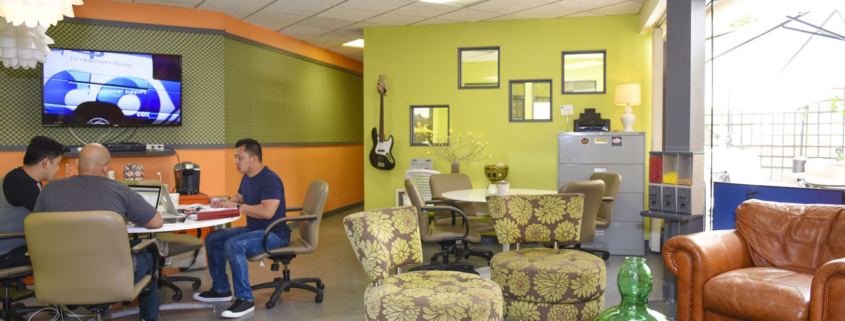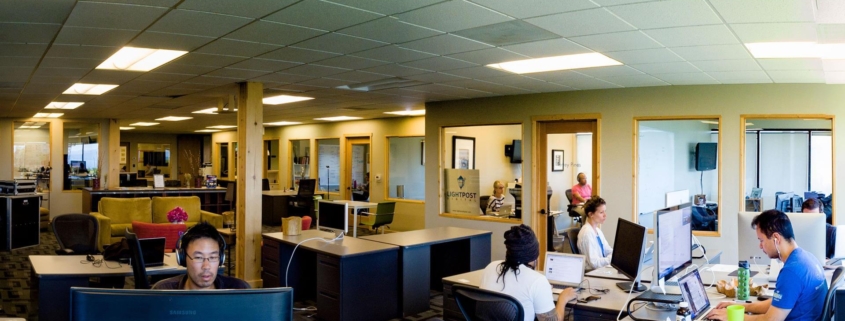Mo Rasheparian, general manager takes us on a tour of NEST, www.cybertechnetwork.org, as part of San Diego Coworking Week. At 16,000 square feet, NEST is one of San Diego’s largest Coworking spaces, and mixes Tech focused business such as CyberTech (CyberHive), Internet of Things (iHive), and Emerging Technologies (xHive) with lifestyle businesses.
The largest incubator in downtown San Diego, CyberTECH NEST is a coworking space for entrepreneurs and small business, particularly those in cyber, Smart City, Internet of Things and other innovative technology. This is where the next great idea could be launched. The City of San Diego helped fund its expansion.
If you are looking for the coolest spots in San Diego to work from or just have sip of coffee or looking for a 3-D printer…these are the spots for you, with your Nest CoWork being one of the cool featured spots.
Nest was featured in a Top 10 list by the professionals at Surf Office, here is what they wrote about us,
Rating 8.6/10 | 1855 1st Ave #100, San Diego, California | Website
+ NEST Cowork is home to a cool coworking space with a great vibe, awesome networking opportunities and incredible views from the second-floor hot desk area.
+ They offer tons of membership perks including dinners, happy hour events, yoga, coffee, and more!
+ The staff are super friendly and very helpful, always willing to assist and answer any questions or concerns.
– There is only metered or 2-hour parking available on the street.
– The conference room is only good for up to a maximum of 10 people.
Most of the time, you just need a quiet space to sit and work. And your co-working space is a great way to meet that need. But co-working spaces are more than just a desk and cup of free coffee. Co-working spaces provide several avenues into your local community that can help you build networks and a generate a balanced work-life mix.
Meeting Rooms
As a member of a co-working space, you have access to the meeting rooms and common areas. But if you are a solo entrepreneur, you might never really use your meeting room allotment. So, if your focus is on having a quiet desk space, you might let your meeting room hours go unused month after month. But for some non-profit organizations, affordable, comfortable, and professional meeting rooms are hard to find. If you are a volunteer or board member for a local non-profit organization, you can offer your meeting room hours to the non-profit for a board meeting or educational seminar. Most non-profit boards meet monthly during off-hours – like on a Thursday night from 7pm to 9pm. Your co-working space is probably empty during those times anyway. Non-profit organizations frequently need a meeting space once a year for an eight-hour annual planning session. And again, those meetings are generally on a weekend when the co-working space is relatively empty.
Off Hours
Many co-working spaces are available for member use 24 hours per day. But if you walk around a co-working space after 8 pm weekdays, or any time on the weekends, the space is going unused. While one primary benefit of co-working membership is the camaraderie that comes with being around other professionals, sometimes a quiet, empty room gives you the space you need to think, plan, and accomplish. In fact, if you haven’t made the leap to being a full-time entrepreneur, you might be able to negotiate a discounted rate for using the co-working space only during nights and weekends. Plus, when you use the co-working space during off hours, you can dress in sweat pants and a t-shirt. And maybe even bring the kids.
Networking Events
If you aren’t going to the co-working member dinners and networking nights, then you are missing out on a prime benefit. To start, networking events are critical way to find more business. Sure, you might pick up a client or two from within the group of co-members. The key to finding business from a networking event, however, is honing your elevator speech down to a repeatable set of skills you offer. Everyone at the networking event knows someone else who needs your services. By attending the networking event and delivering a compelling elevator speech to ten other members, you are seeding the word-of-mouth marketing that leads to consistent, incoming business. Networking events also force you into much-needed social interaction. Introducing yourself to other members is difficult – especially during a busy workday. But when you add a glass of wine, some jazzy background music, and a cheese plate, suddenly it’s easier to say hello and introduce yourself. By building these social connections, you are creating a more comfortable workday environment for yourself.
Community Efforts
Co-working spaces often have well-established connections to the communities in which they operate. For example, your co-working space might already have a team for an upcoming 5K run to raise money. Or the co-working management might already be donating space to a local non-profit. These pre-established connections are a great way to get yourself and your business into the community. All businesses are built one brick at a time – so by attending the 5K sponsored by your co-working space, you are creating the goodwill that becomes word-of-mouth marketing and more client contracts. You can also bring a community event into your co-working space. Whether you are selling Girl Scout cookies for your daughter’s troupe or looking for volunteers to help clean the beach, you have a wealth of resources available through your co-working colleagues.
Amenities
You might be surprised at some of the amenities available to you as a member of your co-working space. A good co-working space will work to provide a healthy work-life balance to its members. Often that means shower facilities to enable a quick lunch-hour jog. You also might find that there are some exercise machines tucked away in an unseen corner of the office. Make sure to take full-advantage of the drinks and snacks available to members. Your co-working space isn’t really in the business of making a huge profit on the granola bars and club soda for sale at the snack bar; those snacks are there to help you be more productive while working. And if they aren’t carrying your favorite bottled water – ask! Management might be thrilled to add something new to the slate of offerings.
Co-working spaces are built to make your life more productive. But the management team can’t read your mind. Don’t shy away from asking for want you want out of the space. It’s yours – you pay for it – so take advantage of all the features and benefits that come from co-working membership.
The Myth of the Twenty-something Co-Worker
When you think about the typical co-working space, you might image twenty-somethings at standing desks while drinking lattes and snap-chatting about the newest apps. In reality, co-working spaces are multi-generational environments. In a co-working space like NEST CoWork in Bankers Hill, you’ll find a wide range of ages and workers seeking a comfortable yet professional space – from entrepreneurs of all ages launching startups to freelancers to remote workers looking for a quiet, professional place to do their job.
More Mid-Career Start-Ups
Contrary to some popular beliefs, the younger generation doesn’t have a lock on innovative ideas. Certainly, there has been a growing number of Millennials starting their own businesses rather than going to work in a corporation right out the gate. However, entrepreneurs are just as likely to launch a new business at 35 or even 50, as 20. The past several years have seen a significant trend toward mid-level career professionals starting a business of their own as reported by publications including Forbes and Financial Times. Solid business plans and fiscal responsibility, often come from the mid-level professionals who have accumulated the experience and resources to bring a new idea to market. So, for every eager Millennial in your co-working space, there is likely a hard-working thirty-something or fifty-something diligently planning out a business strategy.
The Growth of the Gig Economy
The independent contractor or freelancer is a core group of any co-working cohort. The growth of the gig economy has seen a big increase over the past decade and it’s predicted that the gig economy workforce will double in the next four years. That means 9.2 million Americans are expected to work in the gig economy by 2021, up from 3.8 million last year, according to combined research by Intuit and Emergent Research. Real estate agents, insurance agents, graphic designers, computer programmers and “on demand workers” will occupy a significant percentage of co-working desk spaces.
Remote and Distance Workers
High quality, experienced employees don’t always live close to a corporate headquarters office. So, the co-working space is an affordable, professional solution for any company that wants to provide a desk or office to a distance worker. Concerned about the distractions that come with a home-office, corporations are turning to co-working spaces as a way to keep talented employees focused on work.
The co-working spaces around the country are filled with professionals of every age. That diversity feeds into each community and creates productive and innovate forums for building businesses of every size.
For decades, the traditional field or outside sales representative worked out of his or her car. With a trunk filled with brochures, sales forms, and sample products, the road warrior could spend 95% of the week working from the front seat of the car. But the co-working space has shifted the professional lives of that contingent of the American workforce. Thanks to multiple locations, storage spaces, and a lively crew in every office, remote sales reps are now turning to CoWorking spaces for productivity and professionalism.
Co-working Becomes the Home Base
If you’ve ever visited the home of a company sales rep, you likely saw a garage, spare office, or dining room filled with boxes. (Not everything can fit into the trunk of the car.) Co-working spaces are able to customize rental plans to provide space to solve the sales rep space conundrum. Instead of desk rentals, co-working spaces can offer a few shelves in a storeroom along with a “floating desk” membership. The dining room remains clean and the rep has a home base for paperwork and sales calls.
Part of a Community
Being a field sales rep can be lonely work. With long hours on the road, a sales rep might only interact with colleagues by phone or at quarterly meetings. But with a co-working membership, the sales rep suddenly has all the benefits of a collaborative workplace. With even one day per week at a CoWorking office (instead of at the dining room table or overcrowded café), a sales rep can have a sense of belonging and community.
A Professional Presence
For a sales rep covering several cities or states across their territory, a co-working desk serves as a home-away-from-home. For a regional sales rep, a co-working space provides a professional, high tech environment to hold client meetings or company gatherings.
Outside sales reps no longer have to live out of their cars or coffee shops. Co-working spaces can cater to the needs of the individual rep, ensuring a professional environment and community worth coming home to.
A Freelancer’s Life
Independent contractor, 1099 worker, gig worker, freelancer, short-term employee… all terms for those of us who don’t work the traditional nine-to-five job. Our numbers are growing. And so are the co-working spaces we use to accomplish our work. Sure, the freelance employee can work from home in fuzzy slippers and an old T-shirt, but that’s so 2001. And working from a coffee shop? That’s only good until the noise of the customers rises above the din of plates and mugs. Today’s freelancer needs a base of operations. Plus, with all the benefits that come with great co-working spaces (like NEST CoWork) why would anyone go anywhere else?
Freelancers need an office. Even if they never have a face-to-face meeting, independent contractors need a professional setting. Let’s begin here — productivity comes with a dedicated workspace. Focus is key in accomplishing anything. There are a million ways to fill your day as a small-business owner, but only a few tasks will generate revenue. With a standard desk and chair (in a professional setting) you are simply more likely to get work done.
Everyone who works uses the phone. Even if you’re a programmer cranking out code, you have to connect with supervisors, managers, and clients. You can’t have a professional phone conversation with background noises like the bark of a dog, the clang of a café dish, or the siren of a passing police car. You also need space. A café table just isn’t big enough for your laptop, notepad, and obligatory latte. A co-working space will give you the space you need to talk on the phone, use your computer, and take notes.
Sometimes, you do need to meet a prospect, client, or colleague face to face, and teetering on a café stool and shouting above the foam machine doesn’t lend itself to a professional, confidential conversation. A good co-working space will offer quiet corners and professionally appointed conference rooms that will make you look like a mega mogul and make your client feel confident about sharing the latest secrets about his new product launch she/he wants your help with.
With the quality of video-chat on the rise, meetings via Skype are the most efficient way to add a “face-to-face” meeting into your workday. Holding a video meeting from home has an inherently unprofessional feel. And having a video meeting from a café is simply annoying. Thankfully, co-working spaces are adding video conferencing rooms. With a high-quality feed and enhanced sound technology, a co-working video room can be nearly as effective as a 2,000 mile trip to Dallas.
Selecting the wrong kind of office can be just as bad as working from home. For decades, freelance workers and entrepreneurs have been able to rent “executive suites.” Although these kinds of closed-door spaces provide a professional facade, they can also be cold, tedious places to work. Often, executive suites sit in long, white hallways, and are decorated with beige walls and nondescript art. There is generally nothing warm or friendly about these spaces. The other professionals that share the floor or building may only give you a nod of acknowledgement. Co-working spaces, however, have been designed specifically to combat the dreary, single office environment. Co-working spaces are filled with natural light, comfortable couches, and engaging members.
Although not all working relationships are perfect, working around others is a vital way to stay motivated. Freelance work can be very lonely. Traditional employment gave workers with a variety of personalities. Co-working spaces are inherently more engaging because of the vibe and décor. But, people still need some encouragement. So, co-working spaces will generally have social events to bring everyone out of their respective shells. These kinds of networking events are not always about drumming up business. Frequently, social gatherings are simply a way to bring some cheer to the everyday interactions people have in an office. Without the draw of a free lunch or happy hour, some co-working members would remain inside their cubicle or office. Add some beer, and everyone starts making new friends.
For the freelancer, paying bills and filing taxes is a part of the job. With a dedicated co-working space, the freelancer can add some distance between home life and work life. Home is meant for time with the family. The office is a time for serious business. Of course, everyone has a bit of cross over between work life and family life. So, when the freelancer needs to bring the kids into the office over the weekend, a good co-working space will easily host the kids. Pencils, paper, and cable TV are prevalent in the modern co-working space; and all make for great distractions while Mom or Dad finish up some business.
The demand for freelance workers will continue to rise. The emerging workforce (the Millennials) aren’t interested in the traditional job. Companies are seeing that contractors, remote workers, and short-term employees are effective ways to meet business needs without employment liabilities. Co-working spaces have emerged as the best forum to connect both sides of that emerging trend.
NEST CoWork Welcomes Start-Up Workers and Entrepreneurs during San Diego Startup Week
San Diego celebrated its start-up culture with the 5th annual San Diego Start-Up Week. Within a five-day span (June 19 to June 23), start-up owners and entrepreneurs attended fifteen tracks, more than 250 sessions, and more than 300 speakers. San Diego Start-Up Week attendees also had the chance to visit several of San Diego’s co-working spaces, including NEST CoWork.
We were happy to welcome start-up workers during Start-Up Week, showing them the benefits of the First and Fir office building. Besides the (fully equipped) GRIND Coffee Shop and (awesome) free WiFi, NEST CoWork’s key benefits are its pricing structure and laid-back, creative vibe. “Our plans are flexible — keeping in mind the needs of our members; our pricing is all inclusive, so no surprises at the end of the month,” says Darin Andersen, NEST CoWork founder.
Depending on what stage they are in from seed to growth, start-up companies need flexibility in pricing in order to adapt to an every-changing environment. With hot desk, dedicated desks, cubicles, and offices to choose from, entrepreneurs can expand or retract as needed. Plus, NEST CoWork offers phone booths, conference rooms, patio seating, café seating, and a roller coaster for one-on-one and group meetings. (OK, so there’s no roller coaster. But the patio seating gives you great views of planes landing at the airport!) By selecting NEST CoWork as a home-base, start-up companies have access to a variety of work environments without the confines of a long lease. Plus, with free printing (and free brewed coffee), there are no surprise bills at the end of each month.
San Diego Startup Week showcased access to the CyberTECH network as well as the many functions that members can take part in, including a Pitch Fest sponsored by Procopio and eSentire, a CyberTECH EiR mentorathon, and a Smart City Hackathon co-sponsored by CyberTECH, Cleantech San Diego, GE Current, Intel, and AT&T.
Perhaps, equally important, NEST CoWork has a unique, techy vibe. Although you don’t have to a tech company to connect into the NEST environment, tech start-ups are the core of the NEST membership. Pitch nights, Meet-Ups, and member dinners give NEST its comfy, collaborative feel. By providing forums for formal and informal discussions, NEST members gain access to a knowledge base established by the companies/members just ahead on the start-up journey.
CyberHive Members are able to enrich their workday with coffees and teas thanks to the Grind Café occupying a corner of the first floor at First and Fir. But for some, trying to understand a café menu means Googling a bunch of strange words (like americano and matcha). So to help, we’ve compiled this sampling of lingo from the Grind Café list of options.
- Brewed Coffee: This is just like the stuff you make at home with Mr. Coffee.
- Espresso: Compressed coffee. The caffeine in one shot of espresso equals a small cup of coffee.
- Latte: This is a cup of steamed milk with one or two shots of espresso. (Also available cold.)
- Cappuccino: This is a cup of SUPER frothy hot milk with one or two shots of espresso. (Not available cold. See Frappuccino below.)
- Mocha: Anything that combines coffee with chocolate.
- Americano: This is a cup of hot water with a shot or two of espresso. It’s made to replace a brewed coffee. See story below.
Europeans generally don’t make brewed coffee. Europeans drink instant coffee at home and espresso when at a restaurant or café. During WWII, the American soldiers wanted a brewed coffee – just like Mom used to make. But without any Mr. Coffee makers, the Europeans mixed espresso and hot water to mimic American brewed coffee for the soldiers… thus they created the americano.
- Black Tea: Your basic Lipton tea – has caffeine. Generally referred to as English Breakfast Tea. (Early Grey is flavored English Breakfast Tea.)
- White Tea: Same plant as in black tea, just from young leaves. And so, yes, it has caffeine.
- Green Tea: Again, same plant that makes black tea and white tea, but processed differently. Yes, it’s got that caffeine kick.
- Matcha: Ground up green tea. Very concentrated and so, high in caffeine.
- Chai Tea: Black tea mixed with spices like cardamom and cinnamon. (In most of the world, chai means tea. But in English-speaking countries, it means spiced tea.)
- Herbal Tea: Technically herbal “tea” isn’t tea – any true “tea” comes from one, specific plant. Herbal “tea” is also referred to (correctly) as an infusion. Generally, herbal infusions have no caffeine.
- Mint Tea: Mint tea is not green tea. Mint tea is generally a combination of the mint leaves and other plants that are not from the tea plant. So, it’s almost always caffeine free.
Frappuccino: The Frappuccino is a term trade-marked by Starbucks to describe their ice, blended drinks. It developed as a mix of the word, frappe and cappuccino. You won’t see the word, Frappuccino, used (legally) in any café except a Starbucks. However, you can order an iced-blended beverage almost anywhere now because Starbucks made them so popular.
CyberTECH Launches Entrepreneurs in Residence (EIR) Program
California’s tech-inspired startups drive many of today’s hottest and most innovative products and services, helping to further position the state as the global center for excellence in Cybersecurity, Internet of Things and Emerging Technologies such as drones, blockchain, robotics, and 3D printing.
In that spirit, CyberTECH is proud to announce the CyberTECH Entrepreneur in Residence (EIR) — a six-month, low-rent program designed to build strategic relationships between early-stage companies and CyberTECH’s growing ecosystem of partners and stakeholders.
This innovative program leveraging CyberTECH’s “Social Community Incubator Model” is designed as a major element of CyberTECH’s Smart & Safe Cities initiative, in partnership with CyberCalifornia.
You’re invited to join us in welcoming our initial cohort of CyberTECH Entrepreneurs in Residence at a special luncheon event, as follows:
CyberTECH Entrepreneurs in Residence
- Thursday, Sept. 15, 2016, 11:30 am to 1 pm
- iHive @ NEST CoWork, 1855 First Avenue, Suite 201, San Diego, CA 92101
CyberTECH EIR startups will work independently with the support of the CyberTECH community. In some cases, EIRs may be embedded directly in departments or with Business Units at CyberTECH’s corporate partners to accelerate their business concepts and new technology products and services.
In addition to being assigned to a Mentorship Team, CyberTECH EIR startups will have access to no- or low-cost office space, along with discounted or low-cost software, high-speed Internet, strategic, legal and marketing professionals and other early stage startup services. Some startups may be offered stipends or scholarships from CyberTECH ecosystem companies.
Please join us for lunch Thursday, Sept. 15 to learn more about this exciting new program.
Darin Andersen, CEO/Founder
CyberTECH
Featured Amenities
Full coffee Shop
High Speed Internet
Friendly Staff
Focused Events
Private Phone booths
Conference Rooms
Printers + 3D Printer
Projectors
Video Conferencing
Furniture Included
NEST CoWork
1855 First Avenue, Suite 103
San Diego, CA 92101
Current Offers
Free Day Pass*
Free 7 Days Pass*
$50 Month Membership*
* New Members Only




